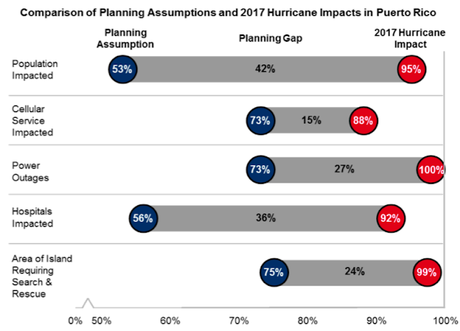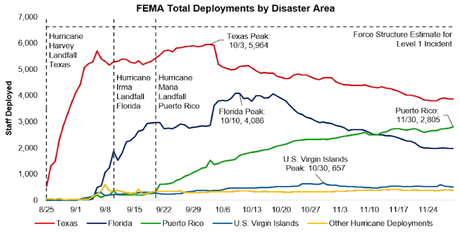

While Donald Trump will never admit it, his administration failed the people of Puerto Rico (American citizens) in the response after Hurricane Maria. The disaster planning was grossly inadequate -- and the response was incompetent, inadequate, and far too slow.
The charts above are from the 2017 Hurricane Season FEMA After-Action Report. The top chart highlights the inadequacy of FEM's disaster planing for Puerto Rico. The second chart shows how slow the response was. After Hurricane Harvey in Texas, it took FEMA about a month to reach peak deployment. It was about the same after Hurricane Irma hit Florida. But it took over two months to reach peak deployment in Puerto Rico -- and that deployment was far from what was needed.
Here is how Arelis R. Hernandez sums up the FEMA report for The Washington Post:
The Federal Emergency Management Agency experienced personnel shortages, was caught with a critical lack of aid supplies, had trouble coordinating logistics and found itself struggling to do the work of the territorial government while responding to Hurricane Maria’s devastation in Puerto Rico last September, according to an official after-action report released late Thursday. Despite repeated Trump administration efforts to play down federal failures in responding to a humanitarian crisis on the island territory, the new report is a public acknowledgment of systemic failures during what was one of the most destructive hurricane seasons — and costliest disaster responses — in the nation’s history. It shows that responses to Hurricane Harvey in Texas and Hurricane Irma in Florida taxed the agency and left it understaffed and out of position for the catastrophe that unfolded in Puerto Rico, where millions of U.S. citizens suffered through widespread communication blackouts, massive infrastructure failures and lengthy power outages. . . . The sobering report runs counter to the White House narrative that President Trump presented at the time, when he praised FEMA’s performance and characterized the devastation on the island as not being “a real catastrophe like Katrina.”. . . In Puerto Rico, the Category 4 Hurricane Maria knocked out communications and left more than 3.5 million residents without power for months while FEMA scrambled to provide food and water and restore electricity. Resources that had been redirected to deal with Hurricane Irma in the U.S. Virgin Islands left few supplies for Puerto Rico when the hurricane hit — and communication lapses, transportation challenges and a lack of situational awareness caused major delays in help for those living on the island. The inability to communicate, or to reach isolated areas of Puerto Rico, was a particular problem. FEMA officials conceded that in the first 72 hours after the hurricane, they had little understanding of what was happening across the island and could not assess road conditions or damage to water and wastewater facilities. A week after the hurricane made landfall, according to the report, officials had been able to assess about half of the island’s wastewater treatment sites and did not have information on the status of 37 out of 69 hospitals.

